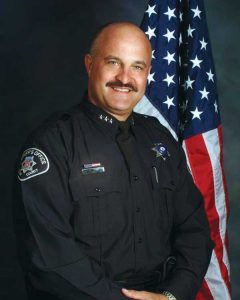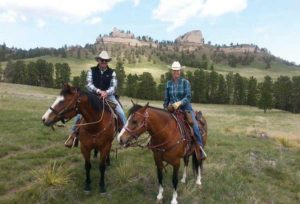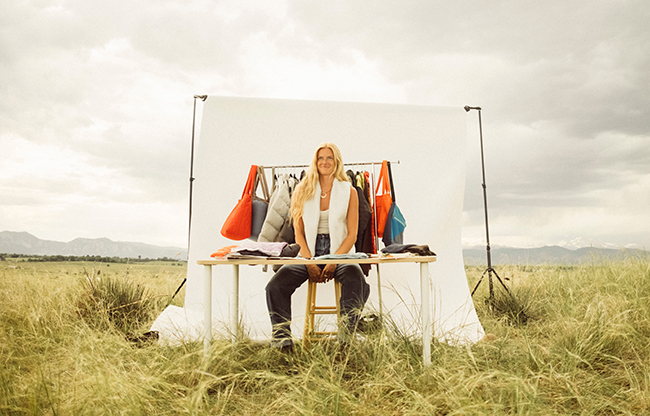Interview with Boulder County Sheriff Joe Pelle
07 Sep 2016
If you put 10 people in a room and asked them who they thought would make the best sheriff, hands down they’d all pick Joe Pelle.
Sheriff Pelle embodies the personality, character, awareness and compassion needed to be sheriff in our unique community. His steady hand has helped us deal with myriad natural disasters and social issues during his 14 years in office. Pelle, who grew up in Boulder and attended Fairview High School, has had a lifelong career in police work.Elected sheriff in 2003, Pelle previously served with the Boulder County Sheriff’s Department and Boulder Police Department before running for office. Pelle lives on a small farm north of Longmont with his wife, the former Stephanie Booton. They have two grown children and two grandchilden. Tom Brock interviewed Sheriff Joe Pelle in Pelle’s office on July 18, 2016. The two previous weeks had seen containment of the Cold Springs Fire, and the shooting of 12 police officers in Dallas. Boulder Magazine: I know the past couple of weeks have been just crazy for you, so thank you for making the time to speak with us. You’ve been in law enforcement for more than 35 years. Why did you decide to make it your career?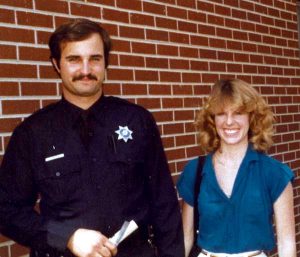
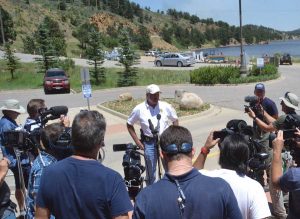
Police Shootings And The Aftermath
You just mentioned you were fighting a wildfire when 12 officers got shot in Dallas. As a law officer, that event certainly had repercussions through your department, and maybe you personally. Has this event and others raised public awareness of what cops face on a daily basis? Well, I think the national awareness has been raised on both sides of the issue. I’m like everyone else. I watch those videos of the police shootings, and I heard and watched the news coverage of the officers who were shot, who were ambushed, and was sickened by it. The bottom line is violence on either side is not going to produce a positive result. I’m really worried about the state of things today. I’ve got a son doing this work. He’s in a different county, but when your kids are involved, your awareness and concern rise to a new level. Plus, I’ve got 225 deputies that I care for greatly and worry about all the time. The sad part about this to me is everybody in law enforcement is being painted with a very broad brush. We watched the actions and improper actions of people in different parts of the country involved in things that have never occurred here and aren’t really a local issue, and yet they’re impacting everybody. Last year we had the marches down 28th Street and the blocking of the road and the chanting of “F**k the cops” in the faces of police officers and deputy sheriffs who have not been involved in racial issues or brutality or anything else, who are doing a good job. I work with 225 heroes—they do great things every day. So for all to be cast in the same mold is difficult. But I think that’s probably the way ethnic minorities have felt for a long time as well. Somehow we’ve got to grow up and embrace each other and figure this out. Do you think dialogue might improve after the recent shootings of police officers and black youth? I hope so. It has to. We can’t continue to go down this road. This isn’t sustainable.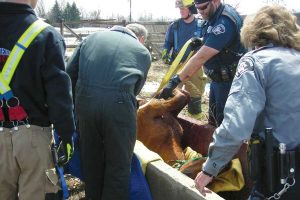
THE JAIL AND FUNDING
Given everything the department does, do you feel as though you’re adequately funded by the Boulder County Commissioners? We do have some funding issues and funding shortfalls, especially on the jail end. The commissioners decided to invest in some consultants to look at the issue and—probably intelligent on their part—to make sure that what I’m telling them is accurate and have an expert verify our needs. But our jail is 30 years old. We currently hold twice as many people as it was designed to hold, and our staff hasn’t increased that much and they’re being overworked and really stressed by a burgeoning population of mentally ill people. People who have everything from an active psychosis to borderline personality issues to bipolar [disorder]. We’ve got the gamut of mental-health problems and so we’re trying to deal with medical issues, medications and that kind of thing. Has the jail staff changed over the years? Yes. We’ve had a number of deputies resign or retire in the last year or two. I review all the completed exit interviews. The safety and the level of activity at the jail and the amount of overtime they have to work is definitely an issue for them. It’s an issue that needs to be solved or worked on. But it’s very, very expensive. And it’s coming on the tail end of a catastrophic flood and the county’s [effort to] financially catch up with that flood. Sounds like the jail is down the tier as far as getting funding. In my opinion it shouldn’t be, because it is one of the biggest liabilities in the county in regards to civil suits and federal rights issues. And it is also one of the only statutory basic requirements of the county governments—to fund a jail and keep the prisoners safe and secure. That’s some of the wording from the old law, but it’s required of the county to do that. I’m hoping that in a few weeks or a couple of months, after this consulting firm has looked at everything, we will come up with a plan to fix this. I don’t think that it will be fixed in my time here, but I’d at least like to have a plan in motion. Do you have input in the consultant process? Yes, a lot, and the main thing they’re doing is pulling data. We’ve had to work with them on the data management system to get the type of data that they need to forecast future needs. The jail is really five different types of facilities under one roof—five buildings with different needs and levels of security. What to build and how to fund it, that’s the big question. Editor’s note: Sheriff Pelle called Boulder Magazine on Aug. 19 with news from the consultants. He said, “The County Commissioners understand the issues at the jail, and have indicated willingness to fund additional staffing and facility improvements.” One of your missions for the jail is to have inmates leave in better shape than when they came in. Is that possible? It’s harder, because we’ve actually been cutting programs at times because of the crowding issue. We’re in split lockdowns now—inmates have to be locked up half the time, so they don’t have nearly the time to participate in programs. We’ve had to convert space that we’ve used in the past for programs into more secure housing, that kind of thing. Crowding definitely has a negative impact on our ability to do programs, but it doesn’t have an impact on our philosophy. And that’s my job. My job is to set a mission and a vision and values around the way we run the jail, and to make sure our staff understands that and lives up to that. Eighty to 90 percent of the people in that jail are going to be back in our community in a few months or a year, and so we need to do everything that we can, under our power and with our funding and time, to try to make them better people, understand their issues, mental illness, substance abuse, codependency. Those things are prevalent in that inmate population. We try to intervene in some way, in a positive way.FACING TERRORISM
The dreadful July 14 terrorist attack in Nice, France, brings home the fact that innocents are at risk almost anywhere. What does the sheriff’s department do for training should a terrorist incident occur? There are nine different police agencies in Boulder County if you look at the small towns and the university police and the city police from Boulder, Longmont, Louisville, Lafayette. None of us has the capacity to deal with an event like that by ourselves. So the first thing that we’ve done as police chiefs is meet regularly, share our concerns and our philosophy. We make sure that we have radio interoperability, training that is consistent department-to-department so officers know how to respond to these things, back each other up and act as one police force rather than individual police agencies. We have some equipment now that’s changed since the days past. We have an armored rescue vehicle that people wouldn’t have tolerated in the ’70s and ’80s, but now they understand the need. Our deputies all carry semiautomatic rifles now in their vehicles; when I started that would have been unheard of and people wouldn’t have stood for it. They train in tactics such as rapid entry on an active shooter, and they train in a fashion that if there were a shooting in, say, Louisville, a Boulder officer, a Louisville officer and sheriff’s officer would team up and become a team quickly and seamlessly and be able to react. We have a lot of large events here that are very soft targets—ball games, the Bolder Boulder and the events at the campus. The campus police are not a large enough agency to provide security at any of those. They all depend on the rest of us, and we provide officers and deputies to those events. We also work in unified command at large events and have practiced over the years. The ICS [Incident Command System] is prevalent now in the fire world and was also used during the flood, but we’re practicing it on a smaller scale with police-type events. You continue joint exercises with other departments? We practice active-shooter and critical-care evacuation drills. The lessons that we’ve learned from Aurora and unfortunately other places are a regular part of their training. It used to be that each agency would practice, and now we all practice together. I also get secure emails and updates from the information analysis center. I get those on a daily basis, sometimes several a day depending on what’s going on.LOCAL CHALLENGES
Boulder County has a growing population of transients and homeless people. What issues do they raise? It primarily affects us in the national forests. I don’t know if anybody’s aware of this, but the west county line is the Continental Divide, so we have all the national forest campgrounds and Forest Service roads along the Peak-to-Peak Highway and up above. In the summertime the population grows by the thousands up there. People come in not only from Boulder and areas down here but across the country. They kind of move in and camp out. So we have health and sanitation issues. We have fire-safety issues. We found two bodies this week, you know. We have issues with heroin and opioid drug abuse. We have issues in the little towns of Nederland and Ward and Jamestown with shoplifting and theft and trespassing and that kind of thing. It does impact us a lot; it’s not just the city of Boulder. Quite frankly the mountain communities are really upset about it. Which is interesting because a lot of them are the hippies that came here in the ’70s, but now they’re residents. What’s your solution to easing these tensions? The caution here is that any time you make a rule, it has to apply to everybody. Mountain residents have been sort of demanding some rule changes lately. If you apply them to the transients they may be helpful, but they have to apply to every family and every person, and that isn’t necessarily a good thing. So you have to be evenhanded and fair about the way you do things and the way you make rules and the way you enforce them. We also have the whole dynamic and discussion about whether picking up their trash or providing them with food or clothes encourages them to stay, and that’s an active discussion in the Nederland area. Since the recent fire they’re very upset about the transient problem and the fire-safety issues. It’s one of those things that needs a lot of thought and discussion and probably not on the heels of a fire. We’re certainly not trying to say YOU can stay and YOU have to go, and YOU can have a fire and YOU can’t. Those are the kinds of positions that we can’t be put in. You got kind of lucky catching the Cold Springs Fire culprits. Will you make an example of them? The District Attorney ultimately makes a charging decision and decides what they’re going to do with the trial. It’s a relatively serious charge because homes were lost and lives were put at risk. The complicating factor with these guys is their criminal past. They’ve both been in serious trouble over time. It’s a decision the District Attorney’s Office is going to have to weigh and consider. We did our job, we did our investigation, found probable cause and made an arrest. Is it good for the community to have closure on that? We’ll see. Like I said, a lot of residents are very angry, kind of up in arms. We’re a little bit worried about vigilante-type activity. Just looking at emails, some things that we’ve seen get pretty ugly. The time to make decisions around these things probably isn’t on the heels of tragedy. I think there are Forest Service policies and state statutes that are antiquated or that don’t apply in the wildland/urban interface like Boulder County as well as they do in places like Wyoming or Idaho. As far as camping, as far as dispersed fires, we really need to look at all of those things. And we are. We’re engaged in ongoing discussions with the Forest Service and mountain communities about those. But there isn’t really any place in the mountains in Boulder County that you can go shoot a high-powered rifle and not be within half a mile of a house. There’s not many places you can go in the backcountry and have a fire that doesn’t endanger a bunch of homes. It’s changed here. You mentioned opioids and heroin. There seems to be a national epidemic. How much of an issue is this in Boulder County? Are there many deaths? It’s an issue. I think we’re going to find an increasing rate of death like we did the last couple of years. It’s just been exponentially growing. Years ago there were one or two deaths, and I think last year there were 14. It’s not like car accidents, but it’s growing and it’s a concern. The sheriff’s office hosts the county drug task force, [which includes] officers and deputies from all the departments. I don’t think this is a problem we’re going to enforce our way out of. As a community and a society, we need to be investing heavily in treatment and intervention. On the other hand, I don’t think we throw enforcement out the window. I’m not actively out trying to arrest heroin users, but we are actively trying to interfere in the supply chain. This year you instituted the use of a drug to reverse an overdose. Yes, Narcan. We actually had a save in the jail. There’s a portion of the jail that is work-release, where the people come and go. If they’re on a misdemeanor charge we can’t strip-search them, so we get contraband in that part of the jail at times, and we had a guy overdose. The nurse on duty had Narcan. [The inmate] wasn’t breathing when they found him and they were able to revive him. A few years ago you came out in support of driver’s licenses being made available for undocumented workers. Why? There’s a percentage of car accidents that end up being hit-and-run, and traffic stops that end up being chases, that are caused by unlicensed, uninsured drivers. Driving a car and having a job go hand in hand—you have to have one to do the other. We’ve decided that the undocumented can’t have driver’s licenses, so we’ve created this whole class of risk. I know that in states where they’ve [issued licenses to undocumented workers] they’ve seen a huge increase in the percentage of licensed insured drivers. Given the opportunity people will go get this license and they’ll buy insurance. You know, this isn’t about immigration. This is about if you’re sitting in an intersection and you get rear-ended by a driver, would you like them to have a driver’s license and insurance? ’Cause they’re going to be out driving anyway. They’re trying to get to work, they’re trying to make a buck. I just think it’s backward thinking otherwise. That’s something that has to be decided at the state house? Correct, and they actually passed the law. I went to the Capitol and testified in both subcommittees for it, worked with the immigration-rights council to get it passed. Then, unfortunately, a conservative side of the house, through the joint budget committee, didn’t reverse the law but they defunded it. So what was going to be 12 offices issuing those licenses has turned into two or three. There’s a backlog, and they created a black market of people selling licenses—again, the whole thing is backward thinking in my opinion. Regardless of how you feel about immigration, this is a public-safety issue and it affects all of us, not just the people who can’t get their driver’s license.